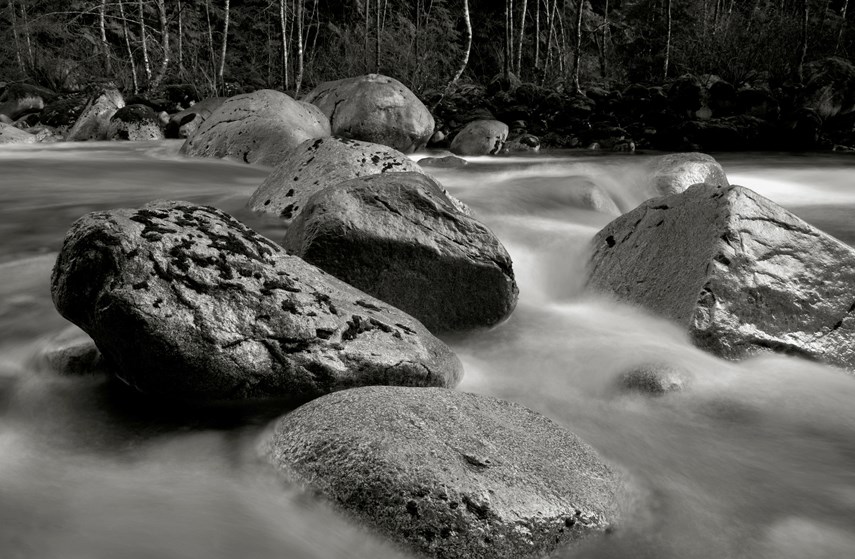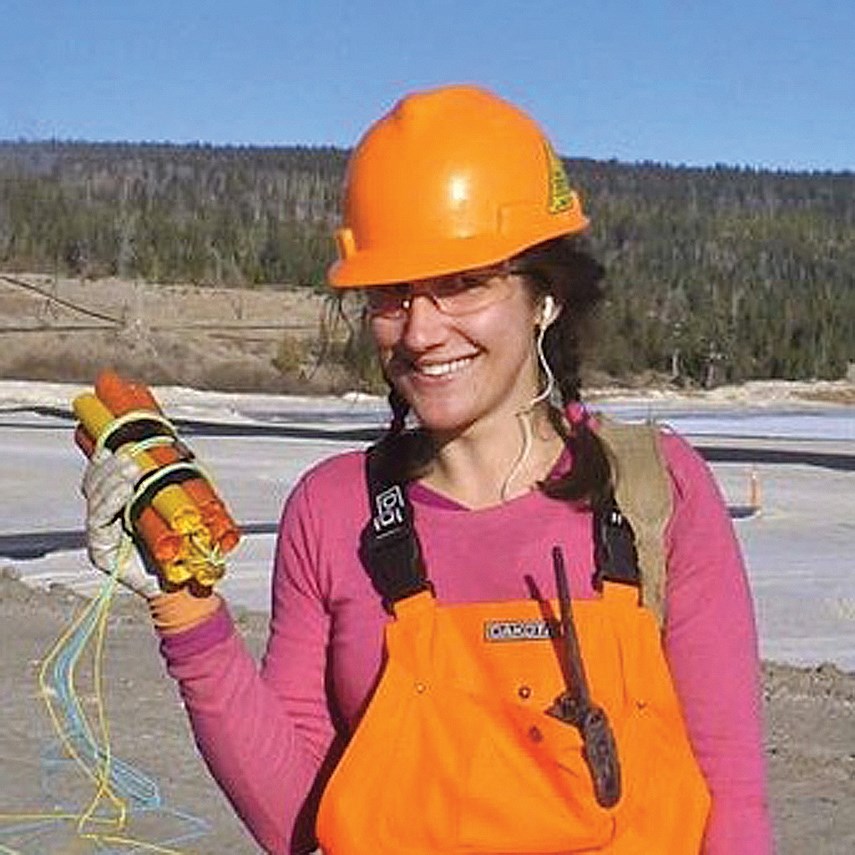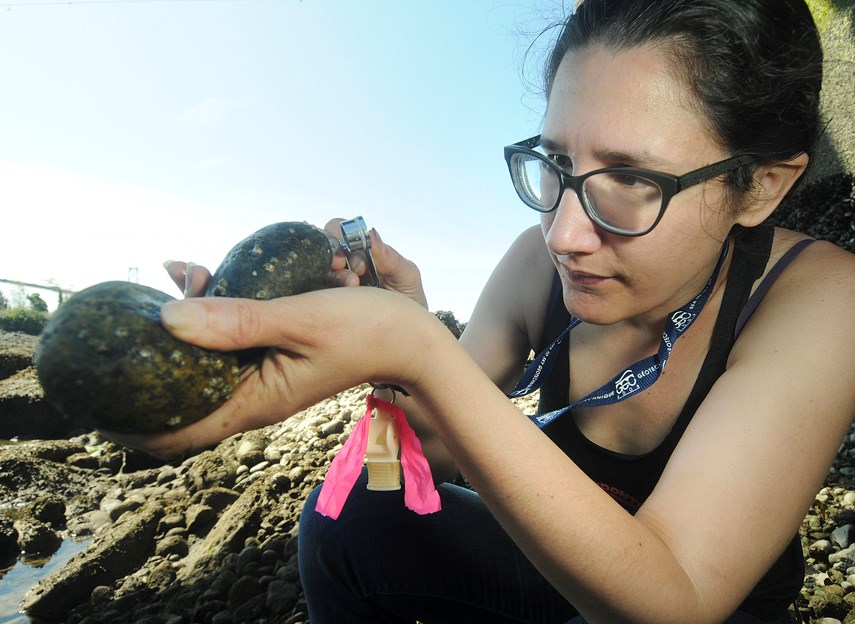Rocks are stories. Geologists, then, are storytellers.
Picking through igneous and sedimentary stones scattered along Ambleside Beach, geophysicist Mika McKinnon gestures to the pebbles in her palm and the mountain peaks in the distance. She starts to tell a story. It’s the North Shore’s story.
“We’re a history of fire and ice,” she begins.
North America’s crystalline heart is east, its edge looping from the northeast corner of Alberta down to where the Green Bay Packers play. But beyond the Canadian Shield there’s a suture seam that divides B.C. from Alberta more than wine or pipelines ever could.
Around 70 million years ago there was upturning, folding, and a “huge geologic mess,” McKinnon says. The Rocky Mountains are traffic cones that popped up after the crash.
Everything west of those 1,000 rippling ranges is a land of immigrant rocks.
“We’re like the leftovers,” McKinnon says.
In very non-scientific terms, B.C. is bread crumbs that became a loaf.
Imagine a deep-dish pizza – deeper than Chicago-style by 100 kilometres and as hard as Latin calculus.
Picture two of them, subterranean strangers in the night moving much slower than the hour hand on a clock. The reason they move at all is because they rest on mantles “somewhat akin to toffee or silly putty,” explains John Clague and Bob Turner in their book Vancouver, City on the Edge: Living with a Dynamic Geological Landscape.
The crusts bump. One takes the Michelle Obama route and goes high. The other slides beneath, scraping up silica and trapping gas, gas, gas.
And from that chance meeting, volcanoes sprout like luxury condos.
McKinnon rubs her thumb against an igneous rock, scraping off the grit. If the rock offers a ghost of a sparkle, it’s likely igneous. The darker it is, the more explosive the volcano was, she explains.
Following an eruption, this rock rested underground. It was goo that cooled and crystallized over 10, 20 or 30 million years while everything on top of it eroded away. It’s in McKinnon’s hand this afternoon because the river, drawn by the insatiable sea, gave the rock a lift. She puts it back down.
Look at the size of the crystals, McKinnon says, picking up another. This one’s granite that cooled slowly. She inspects a blue rock.
Bluestone, she says. It’s ocean floor sediment squished into existence. The green ones are greenstone.
“Because we’re very creative in our naming.”
In examining each rock, the first question is always the same: “What was its life before it met you?” McKinnon asks.
There’s sedimentary, the geologic equivalent of a rock ’n’ roll supergroup. The pieces don’t fit but they joined up anyway. Quartz is usually white, but it can also be a technicolour dreamcoat of yellow, blue, green, purple or red.
And then there’s metamorphic, the most human of rocks. They were something else before the pressure of the world forced them to change.
If the rock is light in your hand, it’s likely because magma bubbled, cooled, and turned into pumice.
The North Shore’s oldest rocks, dark-speckled igneous, dot the top of the Lions and Crown mountains.
From ancient to infant
There’s a spot in northern Quebec where the rocks, by the most conservative estimate, are nearly four billion years old. It’s a greenstone belt that was ancient when the first herrerasaurus tromped the Argentina lowlands looking for a meat lovers’ special.
While dating is “complicated by intense folding and faulting,” the North Shore is largely underlain by 100-million-year-old granite, writes John Armstrong in Vancouver Geology.
Put another way, the North Shore is “baby rocks,” McKinnon explains. Geologically, we’re barely here. And in the case of our mountains, fresh from the freezer.
Formed mainly by crystals of feldspar and quartz, the North Shore mountains are the “frozen remnants of subterranean magma chambers,” Armstrong tells us.
Thirty million years ago they were the FedEx of magma, a distribution hub supplying a network of volcanoes.
Today’s mountains are the roots of those volcanoes. They survived because they rose faster than the streams could cut them down.
If you want to see the imprint ice left on the North Shore, look at the mountains and notice how, in some cases, they meander smooth and round until, just before the top, they turn jagged.
“The ice is like a giant sandpaper that smooths everything out,” McKinnon says.
As recently as 15,000 years ago the tallest peaks stretched above the freezing line like a shark’s fin.
“Pretty much all North Van was underneath the ice,” McKinnon says. “And anything that was flat wasn’t here at all.”
If you pick up a rock here, McKinnon says it probably has quartz in it. In areas with low levels of silica, gas slips from mountaintop like puffs from a pipe. But quartz is a hoarder. And when magma moves for higher ground, quartz keeps the gas for itself, a miser clutching more and more until its grip finally weakens.
In Norse mythology, a world is created when a land of flame strikes a void of frozen fog. The North Shore’s story is much the same.
McKinnon theorizes that eruptions on the North Shore were similar to Mount Pinatubo – a cloud of ash and gas rising like a vengeful spectre as a torrent of lava escaped.
Siwash Rock, an igneous outcropping that starts under the North Shore and stretches alongside the Lions Gate Bridge before emerging at Stanley Park, is one of those spots where lava left its tattoo 30 million years ago.
Armstrong cites West Vancouver’s Sentinel Hill as a “small remnant” of volcanic activity from that era.
You can see the hangover of the volcanic age in the chalky white rock of Mount Seymour where minerals were “turned to clay by hot corrosive waters,” Armstrong writes. Farther down Seymour, there’s brown rock with white fragments that formed either by explosion or “the crackling of a hardened lava flow top,” Armstrong writes.
At Seymour’s peak there’s igneous rock with purplish quartz. And if you look closely, Armstrong notes, you can find small cavities with pixie-sized crystals. Those are remains of the rocks that cooled high in the Earth’s crust like a pie on a windowsill.
Some of the North Shore’s oldest rocks are in Caulfeild. They formed deep in the Earth’s boiler room where magma fell over its fractures, eventually forming granite.
But most intriguing for McKinnon are the columnar basalts near the CN Rail site. As a rule, columnars are vertical. But those ones curve to a centre point.
“We’re pretty sure that’s because there was an eruption under ice,” McKinnon says. “It’s small and it’s beautiful and I’ve never heard of anything like it anywhere else.”
After lava and ice danced, the land took shape.
“We had glaciers come and chop the toes off everything,” McKinnon says. “And then we have earthquakes and rain so everything wants to fall down all the time.”
The flat parts of North Vancouver are the product of landslides. But the canyons are something else again.
Grand canyons

At first glance, Lynn Canyon is a puzzle. The curves of a river usually act like traffic calming measures, but in Lynn and Capilano canyons the curves only seem to quicken the water’s pace.
It’s because the canyons were once pancaked by a two-kilometre-thick ice rink that, at its coldest, ran from the Yukon to Idaho.
“Giant, slow-moving rivers of ice scoured and shaped mountain valleys, pushing enormous amounts of eroded rock in their paths and in the process, grinding it down,” Armstrong writes.
North Shore rocks laboured in perpetual winter under the weight of immense glaciers until, finally, there was spring.
And as the glacier-fed sea level burbled 200 metres higher than it is today, new life emerged as shrubs, moss, subalpine fir and spruce found footing in the cool climate.
Like a child with chocolate fingertips, the glaciers left a trail. On melting they dropped sand, mud and boulders – some of which still serve as decorations marking roundabouts.
“Every time we see a giant, huge boulder where you look around and go: ‘Where did that come from?’ – that’s a glacial erratic,” McKinnon explains.
As the glacier dissolved into a hot mess, Lynn Creek flowed into and over rock, carving its delta drip by drip over 13,000 years, according to Clague and Turner.
The land once depressed by a glacier lifted into canyons. It’s that process, called isostatic rebound, that gives the river its energy.
And if the canyons seem different now than where you first visited as a teenager, it’s because they are.
The post-glacial rebound is still going on, McKinnon says, a couple centimetres each year.
Speaking of a couple centimetres a year . . .
The notion of barely measurable progress resonates with many North Shore drivers.
When you study a geologic map of B.C. you see a repeating sequence of mountains and valley in thin strips scraped off the Rockies. It’s optimal for north-south travel, but a mountain-hopping hindrance heading east-west.
“Real life is complicated and nothing is ever as clean and tidy as [our] textbooks – but the North Shore kind of is,” McKinnon says.
There is, she notes, an exception.
We live on the edge of a geological mystery. About every 300 days, the Cascadia subduction fault shuffles.
If you’re sitting on top of the shuffle it feels like a Mack truck rolling past your motel window.
“It’s only here,” McKinnon says. “Nowhere else in the world does it.”
There’s a reason for it. Of course there is. But no one knows what it is just yet.
“It just is,” McKinnon says.
Master of disaster

McKinnon is a freelance scientist. She was the scientific adviser on the TV show Stargate Universe and sometimes wears a ball gown when she attends pop culture conventions – both for personal space and to challenge preconceptions about what a scientist should look like. But her absolute specialty, she explains, is disasters.
“I literally have a master’s in disasters,” she clarifies. “Technically the degree title is geophysics but it’s a disasters degree.”
She thinks about landslides, the bedrock in Lower Lonsdale, and the fact that fingernails grow at the same rate tectonic plates move.
“Every time you go for a manicure, you’re that much closer to the next big earthquake.”
One of the great advantages of life on the North Shore is easily available data provided by the District of North Vancouver GEOweb program.
“I feel like I can make smart choices when I’m on the North Shore, which is not something you can always do.”
But there is an ongoing disaster on McKinnon’s mind. Because, much like any political discussion seems to work its way to the U.S. president, any conversation about the environment eventually shifts to climate change.
Writing in 1990, Armstrong identified Caulfeild Cove and Lighthouse Park as being vulnerable to flooding.
Considering the future of human beings on the Earth, McKinnon notes the absence of a certain rock in Ambleside: stromatolites.
In the days before the Earth had air to breathe, stromatolites produced oxygen. So much so that they oxygenated the oceans and after they saturated the ocean, fresh air trickled into the atmosphere.
The oxygen was great for everything in the world except the stromatolites that were the catalyst for the great change.
“They’re now an extinct rock. The conditions to form them will never exist again. It’s done,” McKinnon says.
Right now, she notes, humanity is engaged in a similar, unintentional experiment.
“The last time a species was so successful at rapidly changing climate, almost all of them died off,” she says. “I would like to be smarter than algae.”
It’s a low ambition, she acknowledges. But an important one.
One of the most amazing things about science is that you can shape your future. And while the old normal has likely vanished, there’s a new normal that can be achieved, McKinnon emphasizes.
“It’s never too late to make things less bad,” she concludes.
And for today, that’s the end of the story.



